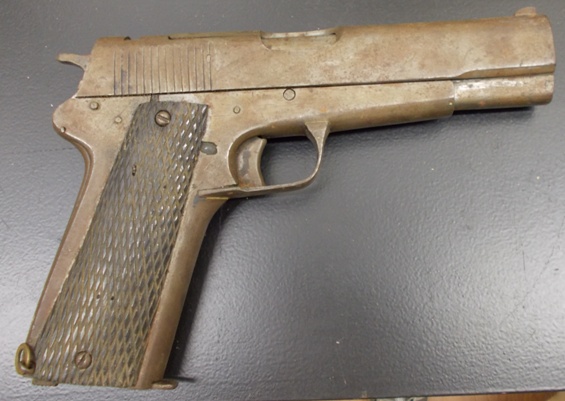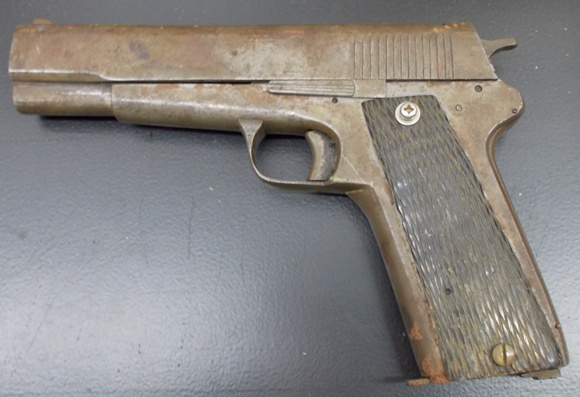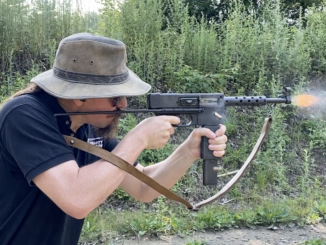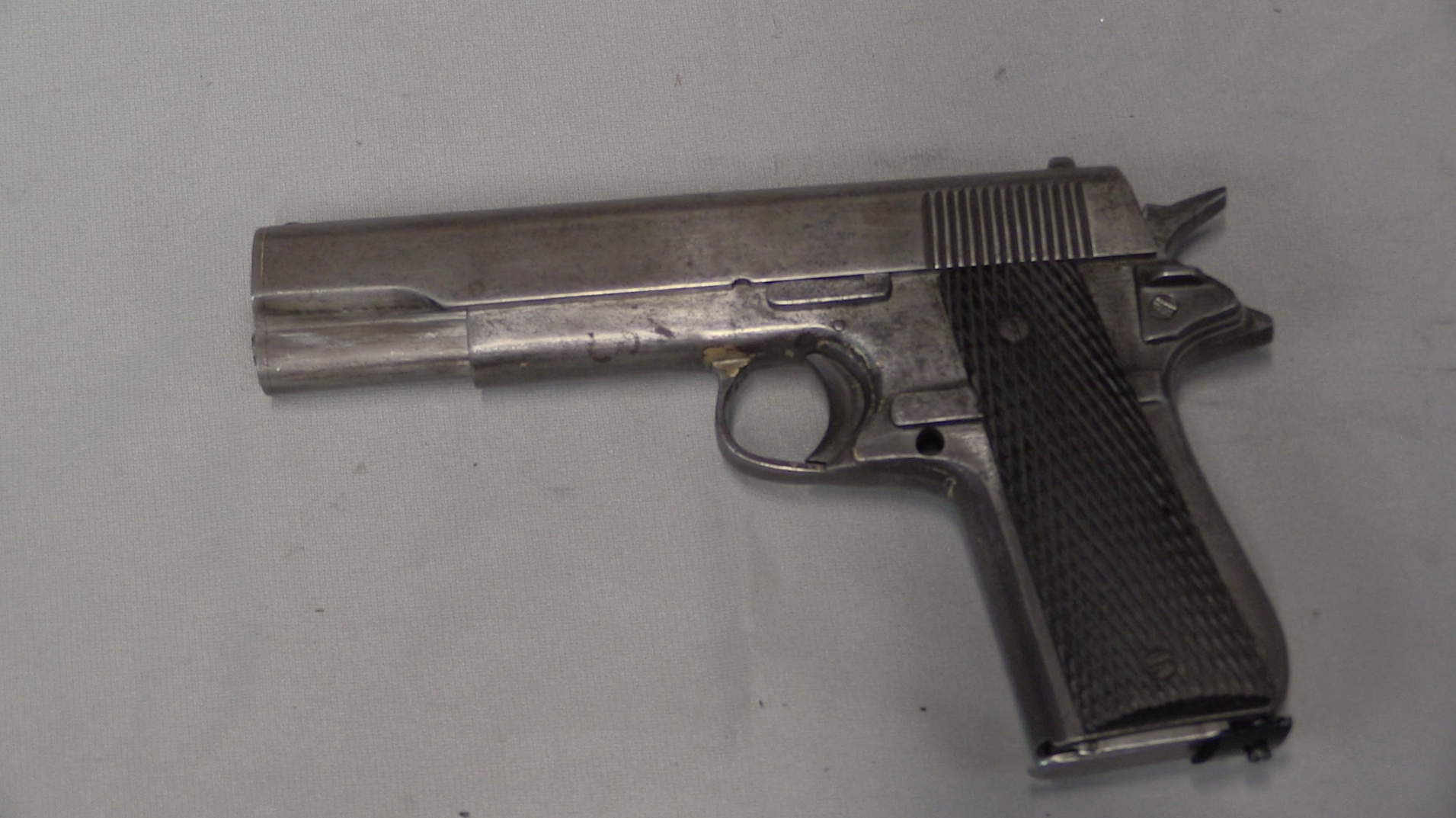In recognition of Halloween, we have a pistol that would be genuinely frightening to shoot, straight from the jungle shops of the Vietnam War. Made out of desperation and a lack of factory-produced arms, a few of these guns came back to the US as war souvenirs. This pistol was modeled after a US 1911 captured by the Viet Cong, and clearly made with a minimum of tooling.
The pictures come from Andrew, who runs Wartime Collectibles. He was buying a veteran’s uniform and insignia, and got the pistol as well:


While the broad outline is a pretty decent duplication of the 1911, there are a bunch of simplifications that have been made. Most obviously, the safety has been omitted, along with the plunger tube for its locking detent. The plunger tube, actually, has been left off all the different examples of this sort of pistol that we have seen. Compared to the other working parts of the gun, the plunger tube is fairly unimportant and fairly tricky to mount properly, so it isn’t particularly surprising to not see it here. In addition, the slide stop lever here appears to be non-functional, as there is not cutout in the slide for it to rotate up into. It’s just acting as a barrel pin.

The extractor is visible here, and is of the external type instead of the 1911 internal design. Again, this is simpler to build this way.

And the magazine release has been put in the heel of the gun. Not the number of holes in the magazine – apparently the gunsmith here didn’t recognize the significance of the witness holes, namely having one for each cartridge.
Unfortunately, Andrew hasn’t disassembled the gun, so we don’t have any photos of the internal construction. Some of these sorts of guns have no locking lugs, and act as straight blowback actions. Andrew informs us that the barrel does have some play when the slide is retracted, and between this and the barrel pin we can tell that it is not a fixed-barrel gun. Whether the locking system was copied faithfully or just left off remains a question. While we are generally eager to shoot unusual historical weapons around here, I don’t think we would really want to touch off this one. It would probably function for at least a few rounds, but I like my face as-is and don’t really need to risk running a pistol slide through it.
However, if you think it’s a pretty cool gun and want to add it to your collection, Andrew is looking to sell it. He’s asking $1200, and can be reached at wartime@wartimecollectables.com. And hey, if you do buy it and decide to test-fire it, send us video!




It is crude in the extreme, probably the crudest copy of a 1911 I ever saw. I remember seeing another jungle shop ‘1911’ from Vietnam, documented in an article published in a French magazine, but looked much, much better than this example.
I can smell the jungle on it.
Want ComBloc copy of Browning design that is actually safe to shoot, Comrade? Who not Tokarev?? 🙂
I see the pun, but here we aren’t talking about factory-made goods, but of something out of a ‘shop’, probably located beneath ground level, and far, far worse than any (for instance) Chinese or even Khyber Pass ‘specials’… I even hesitate calling the author a gunsmith…
That said… the only appropriate serial number would be “numbah ten.” 🙂
$1200? That dog won’t hunt, Monsignor.
Wow that IS crude! What causes the brown coloration? Simply mud, oxidization or something else? Almost looks like it was sculpture made out of clay. 😛
Viet-Cong… May by philippinian M1911-copy from Sebu-island.
Hmmm… don’t think so: guns made at the Cebu workshops are high-tech affairs if compared to this contraption!
I’m guessing that this weapon ( and its ilk ) must have been made during the early years of the Vietnam conflict, when the supply situation for the Vietcong was much more tenuous and they had to make use of whatever they could lay their hands on or manufacture locally.
Just as important as the operating features — or lack thereof — is the quality ( or lack thereof ) of the metallurgy involved. One wonders what grade of steel was used in this case.
I agree with you, Earl. The specimen mentioned in my first post looked almost legit and seems to have been made when the French left Indochina. Maybe this crude thing was made around that time or even before.
Got to be hard nosed if your gonna shoot that thing. Especially if your fighting a war with it.
The braze joints are interesting – looks like the grip was fabricated as two clam shell halves, with the back of the mag well brazed in too.
Is the slide fabricated from a bent piece of sheet with a separate bolt inside?
The piece is most probably made by soft iron sheets cut and bent by hand and
welded together with exception of main spring housing which seems as pinned as
another piece and breechbolt as hard soldered to the hand bent sheet iron slide
and also the recoil spring tube at front underside.
In detailed workshop conditions, inside extractors are easier to manufacture, but
in hand tool productions, it is harder than outside types.
The pistol should be of blow back operated, since if a small notch for slide stop
catch could not be made, harder to make locking recesses under the slide would be
allready by passed. Besides, the knowledge of producer might not be deep enough to
understand the locked breech necessity. Small longitidunal play of barrel over the
reveiver should come from large tolerances.
I have also seen in a US collection a much better manufactured blowback 1911. It is brazed and pinned costruction and finish blued and uses the standard magazine, There is also a copy of the Enfield revolver.
Is it chambered in .45ACP?
Yep.
Yikes. .45 ACP in that (quite possibly literal) piece of scrap iron?
It has rifled barrel ?
The good question is, what is easier and quicker to make (reflecting the needs of war effort),
this bizzare copy of 1911, or some kind of simple open bolt blowback submachine gun, in dimensions and design similar for example to so called chechen “Borz” type smg (it is not a single type of smg model, rather a dozen of variations that have in common mostly their craftmans style of production where 2 models are never the same-result of many different gunsmiths making it or just not being able to follow the tolerances, or both, it is not known).
In industrial standards too, many simple smgs are way cheaper and easier to make (in machinery and materials) than semi auto pistols (for example Ingram), but logic of human choices and doings is often a very strange affair, especially in not so ideal situation that local vietnamese gunsmiths have found themselves. One is certain – the will to fight will often overcome technical shortages and that is a worrying signal for the invading force.
Neat pistol. I also own a viet cong 1911 copy, better “quality” though. No papers but the pistol was brought back in 1970.
To me it looks more like a copy of the Vis-Radom, the missing beaver tail , and grips, but ofcourse that too is modelled after the 1911…